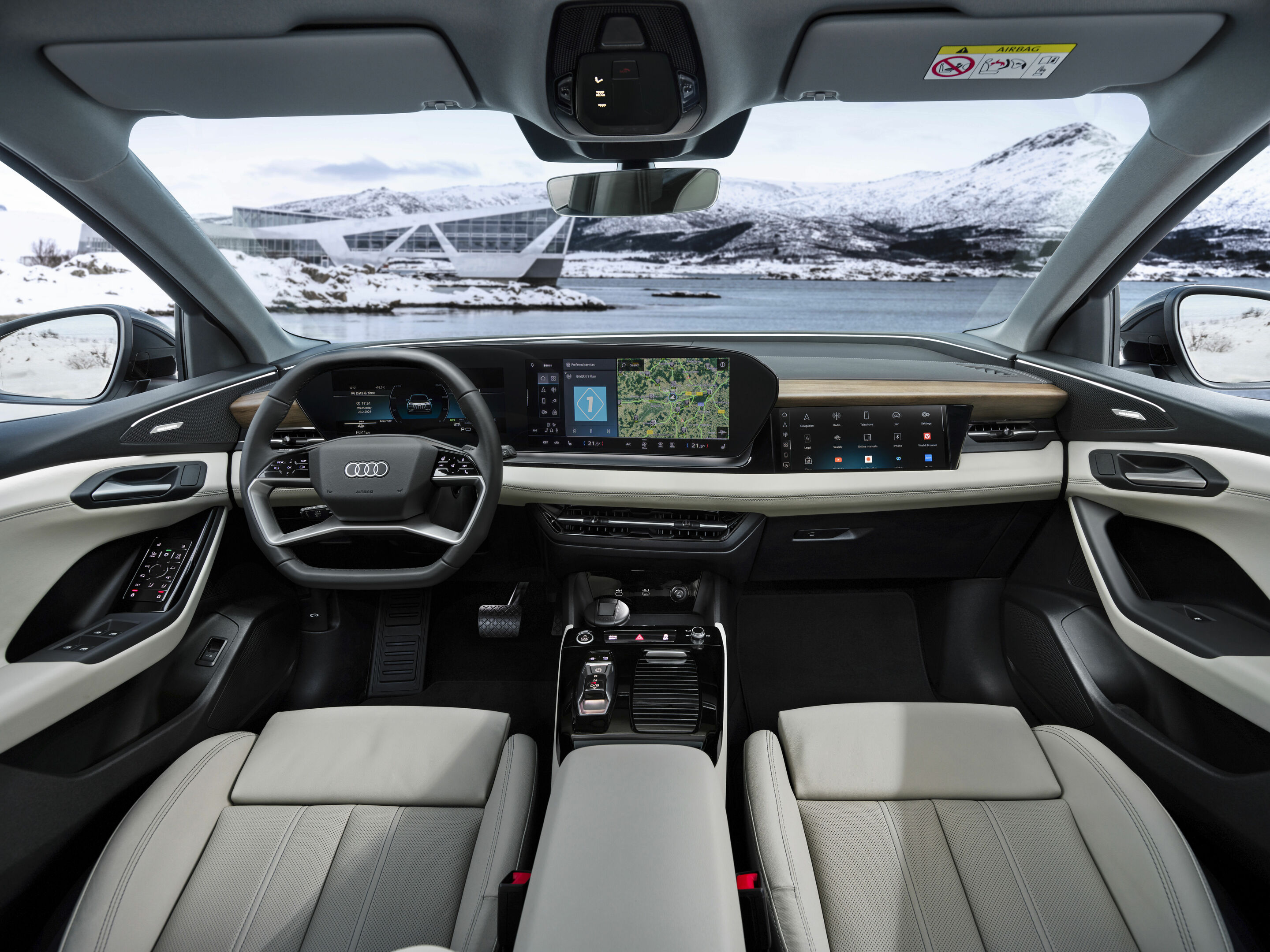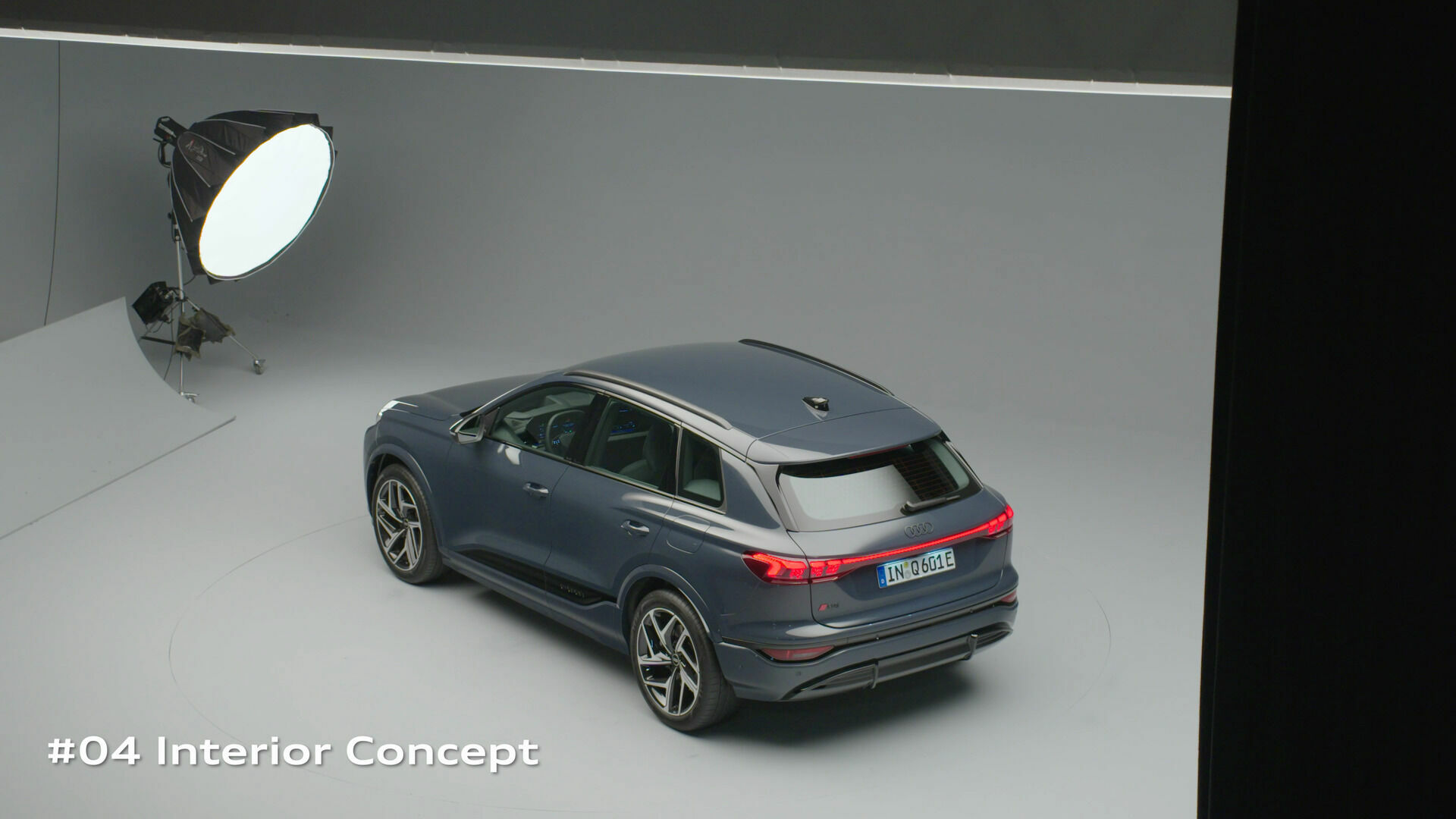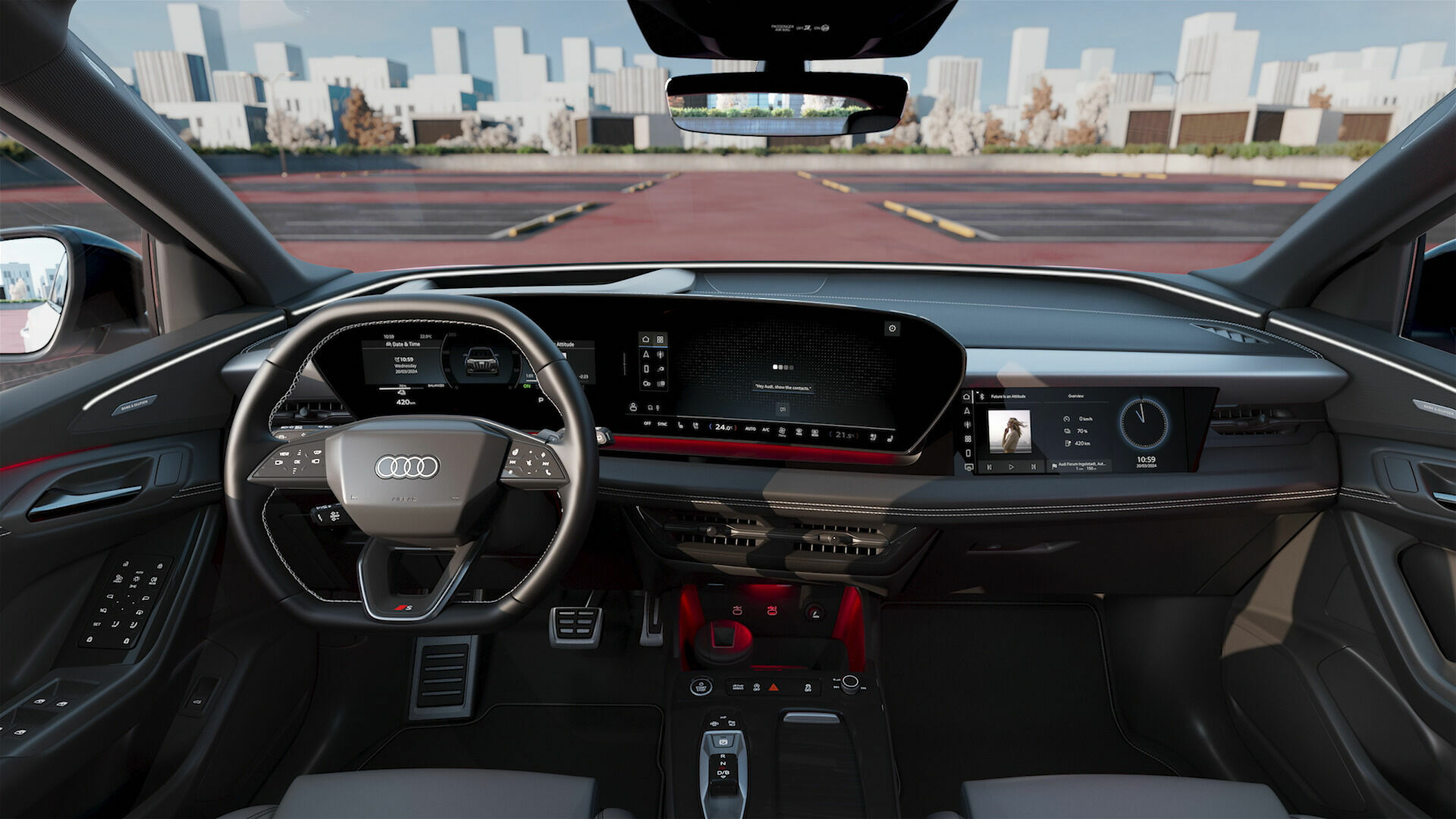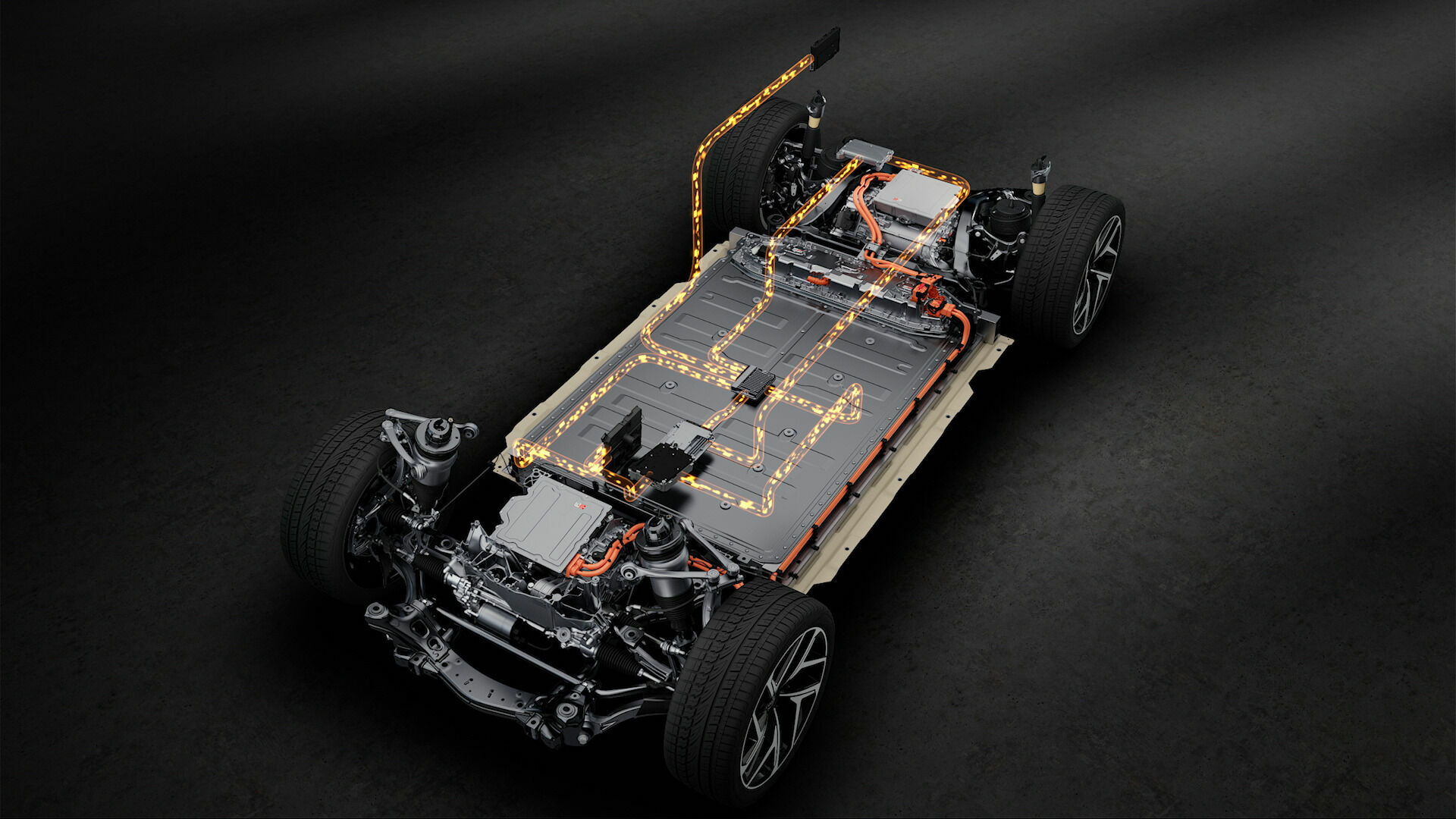Experience digitalization - new display and operating concept
Back to overviewWith the new electronic architecture E3 1.2, customers experience digitalization in the vehicle more directly than ever before. For example, the Audi Q6 e-tron model series has a fully networked digital interior thanks to it. Above the Soft Wrap, the digital stage with
the Audi MMI panoramic display and the MMI passenger display characterizes the interior. The clearly grouped displays are perfectly integrated into the design concept and give the interior a generous and airy feeling of space. The slim, free-standing Audi MMI panoramic display has a curved design and OLED technology and consists of the 11.9-inch Audi virtual cockpit and the 14.5-inch MMI touch display. The driver's area is designed as a curve and the display with its concave shape is oriented towards the driver. The shape of the curved display is also reminiscent of the single frame characteristic for Audi. Special ambient lighting makes the Curved Display seem to float at night. Audi complements the digital stage consistently and individually for the front passengers with the 10.9-inch MMI front passenger display, which is also perfectly integrated into the dashboard design and is being used for the first time at Audi - and in the premium mid-size segment. The display has a reduced layout with eight large tiles and a list on the left with various functions, such as quick access. Thanks to Active Privacy Mode, the person in the front passenger seat can enjoy entertainment content, such as watching movies or streaming series, while moving without distracting the driver. Depending on the content, current speed, and seat occupancy, the light is directed (privacy mode on) or diffused (content visible to all) via an intelligent control unit.
In addition to infotainment applications, the display also gives passengers the option of assisting the driver with navigation tasks or finding a parking space, for example. If the passenger display is not being used or if no passenger is recognized, a digital décor is shown as a background image.
With the optional second-generation augmented reality head-up display (AR HuD), another central element of the digital stage, Audi is taking a major step forward in display technology. The display reflects a large tilted image plane towards the driver via the windshield and shows relevant information such as speed, traffic signs, assistance, and navigation symbols. The image plane is tilted forward to enhance the augmented reality effect. The focus of the human eye moves with it. This process and the large virtual image distance create the impression that the elements shown are floating at a distance of up to 200 meters (660 ft) and interact directly with elements in the environment. The displays, such as navigation instructions, driver assistance system displays, or music tracks, can be seen quickly without irritating or distracting the driver. They are particularly helpful in poor visibility conditions. The field of view for the augmented reality content corresponds to a diagonal of around 88 inches from the driver's perspective and is based on a new digital light processor with a better sensor and data quality and around 1.3 million micromirrors. Drivers look at a display through several mirrors, comparable to looking at a smartphone.
In addition to the improved and more intuitive touch operation, the new display operating concept also takes account of global trends towards interaction. Voice control, for example, has been significantly expanded and now plays a key role. Audi's self-learning voice assistant, the Audi Assistant, can be used to control numerous vehicle functions. The digital assistant with AI support is deeply integrated into the vehicle and is shown for the first time using an avatar in the central touch display of the MMI and the augmented reality head-up display. The new voice assistant recognizes more than 800 voice commands. This means that functions such as vehicle, entertainment, or driving-related tasks can be controlled as required. In addition, conversations can be held, indirect commands can be issued (such as "I have cold feet"), or "multi-intent" commands can be given such as "Set the temperature to 22 degrees and call Peter".
The assistant is activated with “Hey Audi.” It can also be called up via various touchpoints and the myAudi app, for example. With the new display and operating concept, a search for the nearest charging station can be started via voice dialog, and a selection can be made from the list, which is pre-sorted using AI, by touch. Passengers can also use the Audi Assistant. With the help of the microphone module in the roof, the control unit for information electronics recognizes who is entering a command. This allows the system to control whether commands are relevant. The passenger can only control functions that are relevant to them - for example, the seat heating, climate settings, or the power windows on the passenger side, while the driver can control all possible systems.
The spoken commands are also shown on the display ("See what you speak" principle). The interaction light also provides visualization. The intelligent assistant is presented in the Audi Assistant Dashboard, providing proactive tips and inviting you to discover the system's possibilities.
The assistant continuously learns from user behavior and thus supports the driver. This support is divided into three categories: proactive suggestions (context information is used to proactively suggest functions for activation based on this data), smart routines (automatically recognizes recurring operating sequences, such as using the seat climate control from certain outside temperatures) and intelligent lists (such as call lists).
The new electronic architecture and the new display/operating concept are accompanied by a completely new MMI design. The Graphical User Interface (GUI) can be adapted to personal preferences and also adapts to the ambient light settings and the selected drive select mode.
Interaction light stages the interior
The dynamic interaction light (IAL) offers a variety of communication functions and thus supports the interaction of the car with the occupants - a kind of communication at eye level. It spans the interior and cockpit by means of a wide arc. The light strip contains 84 LEDs. It shines with a brightness of up to 1,200 candela.
The interaction light fulfills three central functions: To showcase the interior, for example, it provides a welcome function and indicates when the vehicle is locked and unlocked. Secondly, it supports in the matter of safety: for example, the feature visualizes the dynamic indicator light. However, the IAL always remains an additional display and does not replace a blinker symbol in the Audi virtual cockpit. Thirdly, it provides information such as the visualization of the charge level indicator and the charging process. This is represented by a pulsating light. The dynamic interaction light is part of the ambient lighting package plus and appears in the same color as the contour light when inactive.
The equipment, data and prices specified in this document refer to the model range offered in Germany. Subject to change without notice; errors and omissions excepted.



